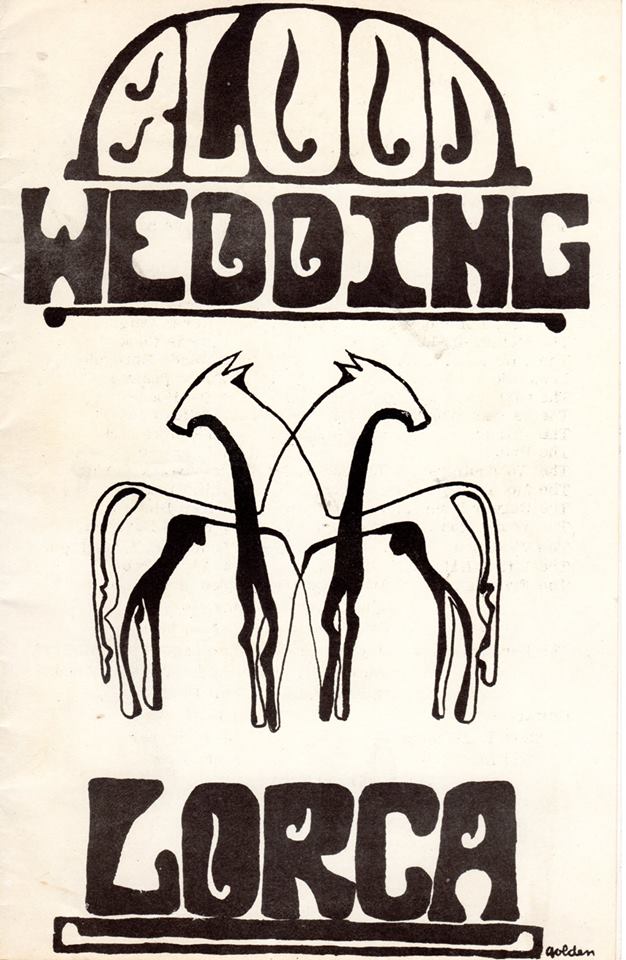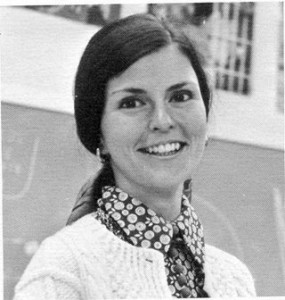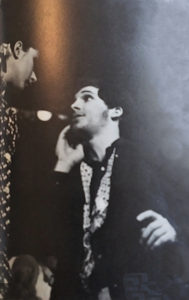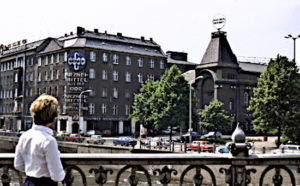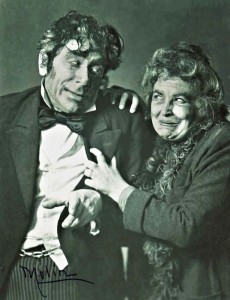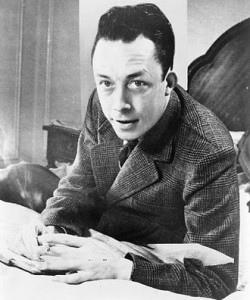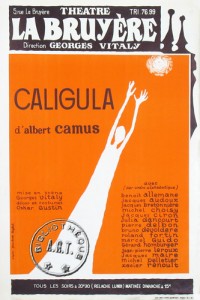At Mamaroneck High School, we had a wonderful speech and drama department, in my time run by very competent and beautiful Regina Frey. Allyn and I got the extra-curricular activity of assisting in the drama department. What a dream!
“We” did “The Skin of our Teeth” by Thornton Wilder, which I happen to have the program for, even though I don’t particularly remember the play. I like Thornton Wilder more for “Our Town”, but Regina’s productions were always first-class.
We did “Rhinoceros” by Eugène Ionesco which I remember quite clearly. I have now learned that the initiative for doing “Rhinoceros” came from Tony Schwab’s parents. Regina was happy to follow up on their suggestion.
The production was a success.The way the actors gradually morphed from humans into rhinoceroses when they are infected by the disease “rhinoceritis” was amazing. Tony was Bérenger, the one man who did not turn into a rhinoceros, but who is still more of an anti-hero than a hero. And this is amateur theater! Ionesco is very clearly using “rhinoceritis” as a symbol for fascism. The whole production was fascinating.
Another memory still very present was the occasion of the tryouts for “Blood Wedding” by Garcia Lorca, probably the most gripping and sad play Regina ever produced.
In the tryouts, a very bright student of mine, Joan Stern, took her seat on the candidate’s chair and started reading several different lines of the Mother’s in the play. We were stunned. The girl was spellbinding. There was no question about it. She was going to make the play a great success – which she did. Well, she and the other actors. Laura Solow, the wonderful musician who was also in my French 3 sophomore class, was the Bride. She was also excellent.
They were all wonderful. I could hardly believe how a young girl like Joan Stern could be a natural actress the way she clearly was. Of course she had the script and she had worked on the part before the tryouts, but hearing her reading the part, almost making us feel that we were seeing the play, was astounding.
I see from a Facebook site on Mamaroneck High School theater that Regina also did a couple of musicals, “My Fair Lady” being one of them. Quite a production for a high school theater group. That was the year when I had a leave of absence and I was in Paris teaching English, on the urging of my wonderful friend and colleague, Janet Rogowski.
I have found out via Facebook that my ex-husband Allyn played the Hungarian fake linguist, Zoltan Kaparthy, who had once taken lessons from Professor Higgins. This was unusual, since teachers didn’t normally act in Regina’s productions. But Allyn would have been a natural to play “that dreadful Hungarian”, as Professor Higgins refers to him, with his beard and long hair. He had, however, let go his seedy-looking hunting jacket for the occasion.
________________
And there was “The Threepenny Opera” – in German ”Die Dreigroschenoper'”. My lifelong connection to Bertolt Brecht’s and Kurt Weill’s masterpiece began in 1946. The play’s first opening in Germany was on 31 August 1928 at the Berliner Ensemble, Theater am Schiffbauerdamm, founded by Bertholt Brecht, a Marxist. However, because of the rising Nazi movement, he and Kurt Weill, with wife Lotte Lenya, were wise to escape to the U.S. in 1933.
‘We’ did ‘The Threepenny Opera’ in April 1946 at our theater in Malmö and I definitely remember certain scenes, even though I was just 13. I was in my first year of German in lycée, and I learned some of the texts of my favorite songs by heart, strongly inspired by Arne of course, who spoke excellent German.
More about “our” performance of “The Threepenny Opera” at Malmö Stadsteater in 1946 in “Chapter 4 – My youth and the theater “.
I saw the movie from 1931 before leaving Sweden for the U.S., The legendary Lotte Lenya, who at that time had a very good voice, not strong but very dramatic, was the whore and ‘Die Seeräuberjenny’ (Pirate Jenny) and she sings my very favorite song with her very natural and seemingly unschooled voice.
I even managed to find that very recording in a CD many decades later in France.
Und das Schiff mit acht Segeln
Und mit fünfzig Kanonen
Wird beschiessen die Stadt.
…
Und legen ihn in Ketten und bringen vor mir
Und mich fragen “Welchen sollen wir töten?”
Und an diesem Mittag wird es still sein am Hafen
Wenn man fragt, wer wohl sterben muss.
Und dann werden Sie mich sagen hören “Alle!”
Und wenn dann der Kopf fällt, sage ich ”Hoppla!”1
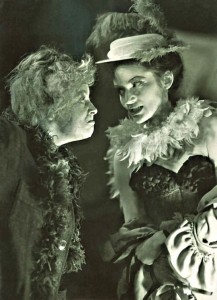
Mrs Peachum is telling the “whore” (Inge Waern) to keep her hands off Mack the Knife. (Photo Molin, 1946)
Sadly I don’t remember our beautiful Inge Waern, who was Pirate Jenny singing that song, but I do remember several other scenes. This was the beginning of my fascination for “The Threepenny Opera”. 2
I was delighted when Regina said they were going to do this wonderful play at the MHS Theater. More about this in Chapter 4 – My youth and the theater
Regina told us later – we were not present at the tryouts – that she asked our number-one male lead, Tony Schwab, to play Mack the Knife. Tony said “But I can’t sing”. Regina just very simply replied “Of course you can”. The part of Mack the Knife does not really require a very good singing voice. This is of course not really an opera and it is mainly Pirate Jenny’s main song that is a bit difficult to sing.
Allyn and I attended many rehearsals, and we even took over for Regina once when she couldn’t be there herself. We became a fixture in this play, more than in any of the other productions. Being Regina’s assistants was our outside curriculum activity, and we could not have asked for anything better.
The show was a great success and even “Der Kanonensong”, which had made Tony particularly nervous, a duo between Mack the Knife (Mackie Messer) and Tiger-Brown came off very well. The two men are reminiscing about their days as soldiers in India.
After the show was over, the whole cast presented Allyn and me with an LP record of the complete set of songs in English. It was a very moving gesture that we greatly appreciated. I had it until our French record player broke down in the late 80s. Before leaving for France, we had to give my Garrard record player to our best friends, since it would not work in France on 220 volt. My Wharfedale speakers are still working beautifully and we complemented them with two of John’s speakers for our bedroom upstairs.
The “Threepenny Opera” was certainly the high point during my six years at Mamaroneck High School, but there was another event that sticks in my mind. Allyn and a younger English teacher colleague had the idea of performing Edward Albee’s “The Zoo Story”, one of my very favorite plays by Albee, which is saying a lot. I didn’t know Allyn was all that fascinated by “The Zoo Story”, but he certainly knew I was.
This was in the spring of 1970 when Allan and I had separated.
I suddenly learned, in fact from Allyn himself, that he was doing “The Zoo Story” with a colleague (whose name escapes me, even though he once took me to a French restaurant on the East side. I called him the over-achiever. He had even studied at Oxford.). I even sat in on a rehearsal, but of course I had no comments to make. Allyn, the former speech and drama teacher, was a pro for this kind of thing.
D-Day came around and it seemed as if the entire school, teachers and all were assembled in the amphitheater Allyn had mysteriously found. An excellent venue (as the term is nowadays) for this kind of small-stage performance. The lights go up and the play begins. We are in upper Central Park and a man is sitting on a park bench, reading a paper, the only stage paraphernalia.
Allyn is Jerry of course, the important part.
Jerry: “I said, I’ve been to the zoo. MISTER, I’VE BEEN TO THE ZOO!” … “And the zoo is around Sixty-5th Street; so, I’ve been walking north. “ … “Good old north.”… “[after a slight pause] “But not due north.”
Peter: “I … well, no, not due north; but, we … call it north. It’s northerly.”
A few trite questions and answers kind of strip Peter naked; he wants to go back to his reading and he is getting a bit irritated by the disturbance. Peter has said that he has two daughters, a perroquet and cats..
JERRY: But you wanted boys.
PETER: Well … naturally, every man wants a son, but …
JERRY: [lightly mocking] But that’s the way the cookie crumbles?
… Oh, look; I’m not going to rob you, and I’m not going to kidnap your parakeets, your cats, or your daughters.
…
PETER: Oh, I thought you lived in the Village.
JERRY: What were you trying to do? Make sense out of things? Bring order? The old pigeon hole bit? Well, that’s easy; I’ll tell you. I live in a four-story brownstone rooming-house on the upper West Side between Columbus Avenue and Central Park West. I live on the top floor; rear; west. It’s a laughably small room, and one of my walls is made of beaverboard; this beaverboard separates my room from another laughably small room, so I assume that the two rooms were once one room, a small room, but not necessarily laughable.
For “Story of Jerry and the Dog”, Allyn had found an excellent solution. It’s an extremely long monologue, so he sets the entire room in total darkness, and he turns on the tape recorder where he has registered the entire speech. It was spell-binding, sitting in the dark, listening to Allyn’s baritone voice telling the long story
And so the play develops into the final scenes with “Move over.” On the bench where Jerry has finally sat down, after just standing still and then walking around. And then again “Move over!”, until Jerry finally manages to get Peter to kill him.
At the end of the play the audience exploded in applause, that seemed to never stop.
Albee has made this put-down of bourgeois mentality and ways of living into a play by having Peter kill Jerry at the end. Certainly the play is also about the emptiness, the meaninglessness of life, but I see it first of all as a denunciation of bourgeois banality. The two aspects are holding hands of course in this play. The perroquet and the knife that kills Jerry at the end. This may also be seen as a second generation existentialist play, and I prefer it by far to Sartre’s “No Exit”.
When I came back from my one-year stint as an English teacher at Paris Université du Sud à Orsay, Regina was married and she had left Mamaroneck High School. I missed her.
__________________
Another high-point theater event took place in the fall of 1971. Le Tréteau de Paris, the famous French touring theater group was going to put on a play, “Caligula'”by Albert Camus at the auditorium of Mamaroneck High School. This was the first time I had seen a play by another theater group performed on our stage.
It got to be a most unusual and fascinating theater performance, not to say unique. Due to a strike by the traffic controllers at O’Hare Airport, the group nearly missed leaving Chicago in time to get to New York for a performance at our high school auditorium. Chicago was where they had last performed. However, the actors miraculously managed to get on a flight to an airport close to Mamaroneck, but all the props and costumes were left behind. That did not deter them, at least not for long. From the stage, before the beginning of the play, as we had been sitting there for quite a while eagerly waiting to find out if there was going to be a performance or not, they announced to us, the audience, what the situation was and asked us to bear with them since they would have to perform the play without props.
It was simply amazing. The actors were so skillful that you almost forgot that they were not really holding the imagined props in their hands. An unforgettable performance, and for more than one reason.
First of all the Caligula in Camus’ play does not bear much resemblance to the historical character. My memory of Camus’ Caligula is of a pessimist, but an idealist, who wants to do the impossible. He is reaching for the moon. It’s the passion for the impossible that stirs this Caligula.
The poster that was given out at the performance was expressive of a man’s wish to accomplish the impossible, and I found it extremely moving. I am not sure if the performance we saw was the same as the one at Le Théâtre La Bruyère in 1970, by Georges Vitaly, but the poster was certainly the same.
It is one of Camus’ plays that belongs to the category ‘the theater of the absurd’ – He speaks of the “utter loneliness”, which could be the characteristic of God. “To be God is to be perfectly lonely.” “Le sentiment de l’absurde confère à Caligula une liberté nouvelle, dès lors qu’il sait que sa condition est sans espoir.”. (The feeling of the absurd gives Caligula a new freedom, as he sees that his condition is hopeless — “Caligula d’Albert Camus” by Raphaëlle O’Brien)
Camus says that Caligula is the “absurd hero” (“le héros absurde d’une peinture de caractère”). Also, on the death of Drusilla, his sister and his mistress, Caligula utters the famous words “Les hommes meurent et ils ne sont pas heureux.” (“People die and they are not happy.” – Caligula de Camus, Act I, scene IV)
I would prefer, however, instead of attempting a scholarly analysis, to keep my own impression of the lonely emperor who dreams of reaching the moon, but in no way is an evil emperor. This was not Caligula the tyrant, but Caligula the poet. Camus himself sees Caligula differently from the impression given by the poster and also by the performance we saw in 1971.
In his own words: “Caligula, prince relativement aimable jusque-là, s’aperçoit à la mort de Drusilla, sa sœur et sa maîtresse, que le monde tel qu’il va n’est pas satisfaisant. Dès lors, obsédé d’impossible, empoisonné de mépris et d’horreur, il tente d’exercer, par le meurtre et la perversion systématique de toutes les valeurs, une liberté dont il découvrira pour finir qu’elle n’est pas la bonne. Il récuse l’amitié et l’amour, la simple solidarité humaine, le bien et le mal.” 3
Continued –Chapter 19 – Paris is worth a mass
-
The heartbreaking performance of Nina Simone who sang it in 1964, transformed it to a Black Power song, completely different from the way Lotte Lenya had sung it.
There’s a ship
The Black Freighter
Turns around in the harbor
Shootin’ guns from her bow
…
And they’re chainin’ up people
And they’re bringin’ em to me
Askin’ me,
“Kill them NOW, or LATER?”
Askin’ ME!
“Kill them now, or later?”
… And in that quiet of death
I’ll say, “Right now.
Right now!”
Then they pile up the bodies
And I’ll say,
“That’ll learn ya!” ↩ - More photos from the performance of “The Threepenny Opera” at Malmö Stadsteater in 1946 – Photo Magda Molin ↩
- Translation – “Caligula, a relatively kind prince so far, realizes on the death of Drusilla, his sister and his mistress, that the world the way it is is going is not perfect, that “people die and they are not happy.” Therefore, obsessed by the quest for the Absolute and poisoned by contempt and horror, he tries to exercise, through murder and systematic perversion of all values, a freedom which he discovers in the end is not good. He rejects friendship and love, simple human solidarity, good and evil.”) ↩


